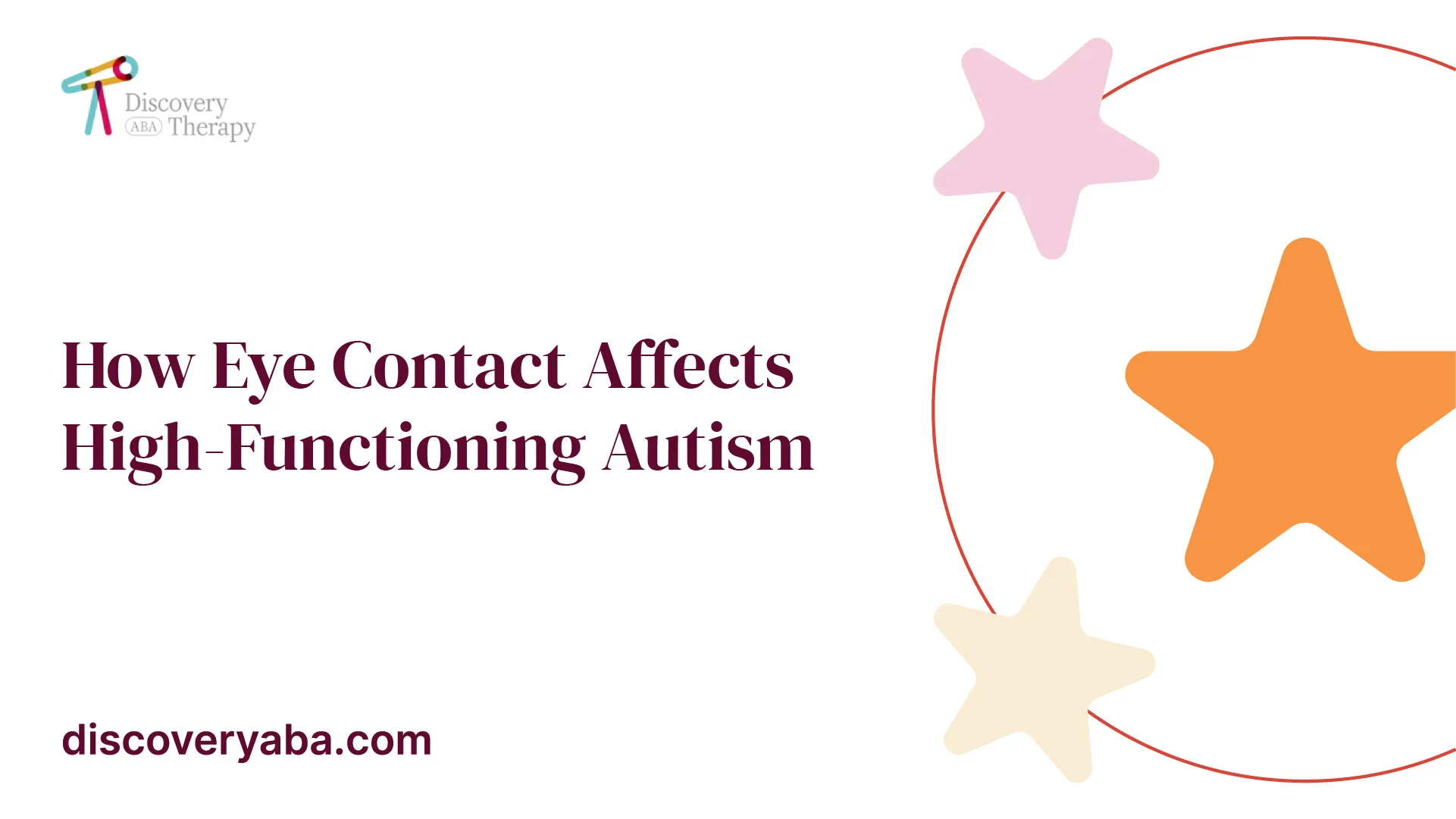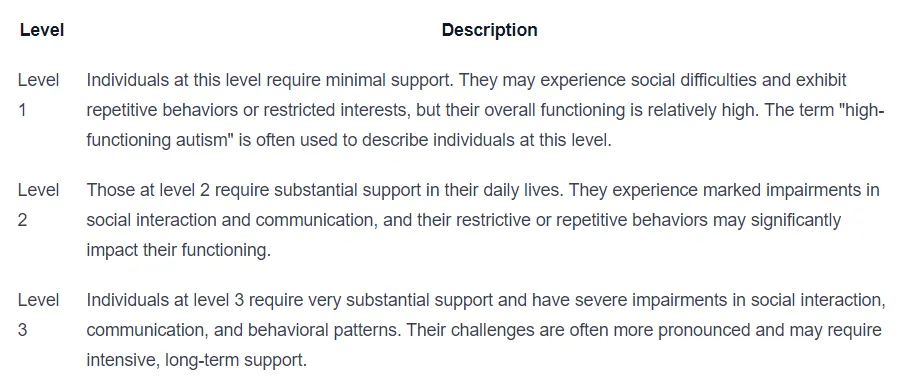How Eye Contact Affects High-Functioning Autism
Unraveling the impact of eye contact in high-functioning autism. Explore challenges, strategies, and the importance of social interactions.

Understanding High-Functioning Autism
To delve into the connection between high-functioning autism and eye contact, it is essential to first understand what high-functioning autism is and the different levels within the autism spectrum disorder (ASD).
What is High-Functioning Autism?
High-functioning autism is a term commonly used to describe individuals on the autism spectrum who possess the ability to read, write, speak, and manage life skills with minimal assistance. While it is not an official clinical diagnosis, the term is frequently employed to refer to individuals with lower support needs in comparison to those with more pronounced challenges in daily functioning.
In the past, the term "high-functioning autism" was often used interchangeably with Asperger's syndrome. However, the American Psychiatric Association (APA) no longer recognizes Asperger's syndrome as a separate diagnosis but instead includes individuals who would have previously been diagnosed with Asperger's under the umbrella of high-functioning autism. This change occurred with the release of the fifth edition of the Diagnostic and Statistical Manual of Mental Disorders (DSM-5) in 2013.

Levels of Autism Spectrum Disorder
Autism Spectrum Disorder (ASD) encompasses a range of neurodevelopmental disorders characterized by difficulties with social interaction and communication. The severity of these challenges can vary widely among individuals, leading to the classification of ASD into three levels:

Understanding the levels within the autism spectrum helps provide a framework for comprehending the varying degrees of support needed by individuals with high-functioning autism. It is important to recognize that each person's experience with autism is unique, and support should be tailored to their specific needs.
Eye Contact Challenges in High-Functioning Autism
Individuals with high-functioning autism may experience challenges with eye contact, which can have implications for their social interactions and communication. Understanding these challenges and the factors that influence eye contact behavior is crucial for fostering understanding and inclusivity.
Differences in Eye Contact Behavior
In high-functioning autism, there are often differences in eye contact behavior compared to neurotypical individuals. It is not uncommon for individuals with high-functioning autism to engage in less frequent or shorter durations of eye contact. These differences can stem from various factors, including sensory sensitivities and difficulties in processing social cues.
Factors Influencing Eye Contact
Several factors can influence eye contact behavior in individuals with high-functioning autism. Understanding these factors is essential for creating a supportive environment and promoting effective communication.
- Personal Characteristics: Personal traits, such as anxiety or sensory sensitivities, can influence an individual's comfort level with eye contact. Some individuals with high-functioning autism may find eye contact overwhelming or uncomfortable due to sensory overload, leading to avoidance or limited eye contact.
- Social Context: Social context plays a significant role in eye contact behavior. Individuals with high-functioning autism may exhibit different eye contact behaviors depending on the social situation. For example, they may feel more comfortable making eye contact with familiar individuals or in one-on-one conversations compared to crowded or unfamiliar settings.
- Sensory Sensitivities: Sensory sensitivities can affect eye contact behavior. Some individuals with high-functioning autism may find it challenging to maintain eye contact due to heightened sensitivity to visual stimuli. The intensity of eye contact or the perceived invasion of personal space may be overwhelming for them.
Understanding these factors helps in comprehending the complexities of eye contact challenges in high-functioning autism. By considering individual differences and the impact of social context, it becomes possible to create a supportive and inclusive environment that respects and accommodates diverse communication needs.
Types of Eye Contact Cues
Eye contact plays a crucial role in communication and social interactions. Understanding the different types of eye contact cues can help facilitate effective communication and meaningful connections, particularly for individuals with high-functioning autism.
Direct vs. Indirect Eye Contact
One type of eye contact cue is the distinction between direct and indirect eye contact. Direct eye contact refers to looking directly into someone's eyes during a conversation, which is considered the norm in many cultures. On the other hand, indirect eye contact involves looking away or focusing on something else while communicating with others.
Individuals with high-functioning autism may exhibit differences in their eye contact behavior, such as engaging in less frequent or shorter durations of eye contact compared to neurotypical peers. It's important to note that these differences are not indicative of disinterest or lack of engagement. Rather, individuals with high-functioning autism may find direct eye contact overwhelming or uncomfortable, and they may prefer to focus their attention on other aspects of the communication process.
Duration and Intensity of Eye Contact
Another aspect of eye contact cues pertains to the duration and intensity of eye contact. Neurotypical individuals often maintain eye contact for extended periods, which can convey interest, attentiveness, and trust. However, individuals with high-functioning autism may find it challenging to sustain eye contact for long durations.
The intensity of eye contact, which refers to the level of focus and engagement in eye contact, can also vary among individuals with high-functioning autism. Some individuals may exhibit intense eye contact, while others may demonstrate less intensity or fluctuating levels of engagement.
To interpret eye contact cues effectively, it is crucial to consider the individual's personal characteristics, social context, and sensory sensitivities [2]. By being sensitive to these factors, one can better understand and respond to the unique communication needs of individuals on the autism spectrum.
Body Language and Facial Expressions
Eye contact is not solely about the act of looking into someone's eyes. It is also influenced by body language and facial expressions. Individuals with high-functioning autism may rely on other nonverbal cues, such as body language and facial expressions, to convey their thoughts and emotions.
Understanding body language cues, such as gestures, posture, and overall demeanor, can provide valuable context to interpret the communication of individuals with high-functioning autism. Facial expressions, including smiles, frowns, and raised eyebrows, also play a significant role in conveying emotions and intentions.
Interpreting eye contact cues in individuals with high-functioning autism requires an understanding of nonverbal communication, recognizing social context, and considering individual differences and personal factors [2]. By approaching these interactions with empathy and an open mind, a supportive and inclusive environment can be fostered, allowing for effective communication and meaningful connections.
Interpreting Eye Contact in High-Functioning Autism
Understanding and interpreting eye contact in individuals with high-functioning autism requires a nuanced understanding of nonverbal communication, social context, and individual differences. By considering these factors, we can foster a supportive and inclusive environment for individuals on the autism spectrum.
Nonverbal Communication and Social Context
Eye contact is a fundamental aspect of nonverbal communication. In neurotypical individuals, eye contact helps convey interest, establish a connection, and aid in understanding others' emotions and intentions. However, individuals with high-functioning autism may exhibit differences in their eye contact behavior, such as engaging in less frequent or shorter durations of eye contact compared to their neurotypical peers. These differences can impact social interactions and communication.
Interpreting eye contact in individuals with high-functioning autism requires taking into account the social context. Different situations and relationships may influence the expectations and norms surrounding eye contact. For example, in some cultures, prolonged or direct eye contact may be considered disrespectful or intrusive. Being aware of these cultural differences and adjusting our expectations accordingly is essential for effective communication and building meaningful connections.
Individual Differences and Personal Factors
Individuals with high-functioning autism are unique individuals with their own set of strengths, challenges, and preferences. When interpreting their eye contact behavior, it's important to consider their individual differences and personal factors. Some individuals may find direct eye contact overwhelming or uncomfortable due to sensory sensitivities, while others may struggle to understand the purpose and significance of eye contact in social interactions.
Factors such as anxiety, sensory sensitivities, and executive functioning skills can also influence eye contact behavior in individuals with high-functioning autism. Understanding these personal factors allows us to approach interactions with empathy and flexibility. By creating a safe and supportive environment, we can help individuals feel more comfortable and empowered to engage in meaningful communication.
In summary, interpreting eye contact in individuals with high-functioning autism requires considering nonverbal communication cues, recognizing social context, and understanding individual differences and personal factors. By approaching these interactions with empathy, patience, and an open mind, we can create an inclusive environment that promotes effective communication and meaningful connections.
Strategies for Improving Eye Contact
For individuals with high-functioning autism (HFA), improving eye contact skills can be a valuable aspect of enhancing social interactions and communication. While challenges with eye contact are common in HFA, there are strategies and support available to help individuals navigate this aspect of social interaction.
Therapy and Support
Therapy plays a crucial role in improving eye contact skills and reducing anxiety surrounding eye contact in individuals with high-functioning autism. Behavioral therapies, such as Applied Behavior Analysis (ABA), have been shown to be effective in improving eye contact skills [2]. ABA therapy focuses on developing coping strategies, improving communication skills, and reducing anxiety around eye contact. Through structured sessions and individualized interventions, therapists can provide guidance and support to help individuals with HFA feel more comfortable and confident in making eye contact.
Therapists use various techniques during ABA sessions, such as reinforcing naturally occurring instances of eye contact and modeling appropriate eye contact during social interactions. By reinforcing small steps toward making eye contact and gradually expanding the comfort zone, individuals can develop the necessary skills to engage in eye contact effectively. ABA therapy can also address sensory issues and help individuals manage sensory overload associated with eye contact.
Coping Mechanisms and Compensatory Strategies
In addition to therapy, individuals with high-functioning autism can employ coping mechanisms and compensatory strategies to navigate challenges with eye contact. These strategies can help individuals manage their anxiety, sensory sensitivities, and social interactions.
One effective approach is to focus on gradually shaping the behavior by reinforcing small steps toward making eye contact. Breaking down the skill into manageable components and providing positive reinforcement for progress can help individuals build their confidence and comfort with eye contact.
Additionally, conversations about familiar subjects and modeling eye contact during social interactions can be beneficial. By engaging in conversations about topics of interest to the individual, they may feel more motivated to make eye contact naturally. Modeling eye contact during social interactions can also provide a visual example of appropriate eye contact behavior.
Supportive environments and understanding from family, friends, and educators are crucial in helping individuals with HFA improve their eye contact skills. Patience, encouragement, and creating opportunities for practice can go a long way in supporting individuals' progress.
While strategies and support exist to help individuals with high-functioning autism improve their eye contact skills, it's important to remember that each individual is unique. What works for one person may not work for another. Therefore, it is essential to tailor interventions to the specific needs and preferences of each individual to ensure the most effective outcomes.
Eye Contact and Communication
Eye contact plays a significant role in social interactions and communication. For individuals with high-functioning autism, the impact of eye contact can be particularly noteworthy. Let's explore how eye contact affects social interactions and the importance it holds in relationships.
Impact on Social Interactions
Individuals with high-functioning autism may exhibit differences in their eye contact behavior compared to their neurotypical peers. They may engage in less frequent or shorter durations of eye contact. These differences can influence social interactions, as eye contact is a vital aspect of non-verbal communication.
Eye contact serves as a key social cue, providing information about engagement, interest, and attention. It can help establish rapport, foster connection, and convey empathy. When individuals with high-functioning autism struggle with eye contact, it may impact their ability to accurately interpret social cues and fully understand the communicative intent of others. Difficulties in understanding facial expressions and contextual nuances can further complicate social interactions.
Importance of Eye Contact in Relationships
Eye contact plays a crucial role in building and maintaining relationships. Making eye contact with others demonstrates interest, attention, and engagement in the conversation. It can help convey emotional connection and understanding. In contrast, a lack of eye contact might be perceived as disinterest, inattentiveness, or a lack of consideration for the communication partner.
For individuals with high-functioning autism, improving eye contact can enhance their ability to establish and maintain meaningful connections with others. It can facilitate better understanding of social cues, aid in communication, and promote a sense of shared experience. Although eye contact may not come naturally for them, developing strategies to improve eye contact can contribute to more successful and fulfilling relationships.
Understanding the impact of eye contact on social interactions and relationships is essential for promoting empathy and creating inclusive environments. By recognizing and valuing the diverse communication preferences and needs of individuals with high-functioning autism, we can foster better understanding and support their social development.
Helping Children with High-Functioning Autism Improve Eye Contact
When it comes to helping children with high-functioning autism (HFA) improve their ability to make eye contact, it is essential to approach the situation with sensitivity and understanding. Forcing or pressuring children with HFA to make eye contact is not recommended, as it may cause distress and hinder their progress. Instead, there are alternative approaches that can be more effective in supporting their eye contact development.
Approaches to Avoid
It is crucial to avoid pressuring or forcing children with HFA to make eye contact. Forcing eye contact can lead to discomfort and anxiety, making it counterproductive to the goal of improving eye contact skills. Instead, focusing on alternative ways to engage in communication and show interest and attention toward others can be more beneficial. For example, encouraging the child to look at something other than the person's face while still participating in a conversation can be an effective strategy.
Effective Strategies and Support
Several strategies have shown promise in helping children with HFA improve their eye contact skills. These strategies focus on reinforcing naturally occurring incidents of eye contact and gradually building comfort and confidence in making eye contact with others. Some effective approaches include:
- Reinforcing naturally occurring eye contact: Acknowledge and praise instances when the child naturally makes eye contact, reinforcing the positive behavior and encouraging its repetition.
- Engaging in conversations about favorite subjects: Encourage conversations about topics the child enjoys, as this can increase their motivation to engage and maintain eye contact during these interactions.
- Modeling eye contact during social interactions: Model appropriate eye contact by demonstrating it during social interactions with the child. This can help them understand the social cues and expectations related to eye contact.
- Shaping the behavior: Break down the skill of making eye contact into smaller steps. Start by reinforcing any attempts or progress made, even if it is a brief glance towards the eyes. Gradually shape the behavior by reinforcing incremental increases in eye contact duration.
- Expanding from familiar to unfamiliar individuals: Help the child become comfortable making eye contact with familiar individuals before gradually expanding to unfamiliar individuals. This step-by-step approach can reduce anxiety and build confidence.
Behavioral therapies, such as Applied Behavior Analysis (ABA), have been shown to effectively improve eye contact skills in individuals with high-functioning autism. ABA therapy focuses on developing coping strategies, improving communication skills, and reducing anxiety around eye contact.
By implementing these strategies and providing appropriate support, children with high-functioning autism can develop and improve their eye contact skills over time. The goal is to create a supportive environment that allows them to feel comfortable and confident in their social interactions, while respecting their individual differences and personal challenges.
Eye Contact in Adults with High-Functioning Autism
Individuals with high-functioning autism often face challenges when it comes to maintaining eye contact, which can affect their social interactions and communication skills. These difficulties with eye contact are commonly observed in adults with high-functioning autism, and they may also experience challenges in coping with social settings.
Challenges and Difficulties
Adults with high-functioning autism commonly have trouble maintaining eye contact without discomfort. They may find it uncomfortable or overwhelming to engage in eye contact, leading to difficulties in establishing and maintaining meaningful connections with others. This difficulty with eye contact can be a result of sensory sensitivities or challenges in understanding social cues.
In addition to eye contact challenges, adults with high-functioning autism may also experience anxiety in social settings. They may find it challenging to navigate social situations, understand social norms, and interpret nonverbal cues. Difficulties with eye contact and social interactions can contribute to feelings of isolation and hinder the development of meaningful relationships.
Coping with Social Settings
Coping with social settings can be particularly challenging for adults with high-functioning autism. They may struggle to understand and respond appropriately to social cues, leading to difficulties in maintaining conversations and engaging in social interactions. In group settings, individuals with high-functioning autism may find it challenging to follow the flow of conversation, understand humor, or grasp sarcasm.
To navigate social settings more effectively, individuals with high-functioning autism can benefit from various strategies and support. Social skills training, therapy, and counseling can provide them with tools to improve communication skills, understand social cues, and manage anxiety. Additionally, practicing coping mechanisms, such as deep breathing exercises or self-calming techniques, can help reduce anxiety and enhance comfort in social situations.
It's important to recognize that every individual with high-functioning autism is unique, and their experience with eye contact and social settings may vary. Providing support, understanding, and creating inclusive environments can greatly assist adults with high-functioning autism in navigating social interactions and building meaningful connections.
The challenges with eye contact and coping in social settings highlight the importance of promoting acceptance and understanding of individuals with high-functioning autism. By fostering a more inclusive society, we can help create an environment where individuals of all abilities feel valued and supported.
Research on Eye Contact in High-Functioning Autism
Understanding the intricacies of eye contact in individuals with high-functioning autism (HFA) requires delving into the research conducted on this topic. Extensive studies have shed light on the differences in brain activity and the abnormal reactions to eye contact exhibited by individuals with HFA.
Differences in Brain Activity
Research has shown that individuals with high-functioning autism have differences in brain activity and processing of social cues during eye contact. It has been observed that they may exhibit atypical neural processing of eye contact, including reduced responses to emotional cues conveyed by facial dynamics. This altered processing can impact their ability to interpret and respond appropriately to social cues provided through eye contact.
Furthermore, studies have revealed that individuals with autism may experience overactivation in the face-processing components of the subcortical system when compelled to focus on the eye region of faces. This abnormal reaction to eye contact stems from excessive arousal caused by overactivation in a specific part of the brain responsible for natural orientation toward faces. These findings highlight the neurological differences in processing eye contact cues in individuals with HFA.
Abnormal Reaction to Eye Contact
Individuals with high-functioning autism can indeed engage in eye contact; however, the mechanisms and functional significance may differ from neurotypical individuals. Some individuals with HFA may struggle to maintain direct eye contact during conversations, finding it overwhelming or distracting. These challenges in maintaining eye contact can be attributed to difficulties in processing social cues, sensory sensitivities, or cognitive load.
The abnormal reaction to eye contact exhibited by individuals with HFA is a result of the complex interplay between social, cognitive, and sensory factors. It is important to note that these difficulties vary among individuals, and not all individuals with HFA exhibit the same aversion to eye contact or face the same challenges in interpreting its purpose and significance.
By further exploring the research conducted on eye contact in high-functioning autism, we gain valuable insights into the neural differences and atypical reactions that impact the way individuals with HFA engage in and interpret eye contact. Understanding these research findings can aid in developing effective strategies and interventions to support individuals with high-functioning autism in navigating social interactions and communication.
Eye Contact in Adults with High-Functioning Autism
In individuals with high-functioning autism, eye contact can present unique challenges and difficulties. Eye contact plays a significant role in nonverbal communication, conveying interest, establishing connections, and aiding in understanding others' emotions and intentions. However, individuals with high-functioning autism may exhibit differences in their eye contact behavior compared to neurotypical individuals, which can impact social interactions and communication.
Challenges and Difficulties
Individuals with high-functioning autism often struggle with eye contact. They may avoid eye contact altogether or find it challenging to understand the purpose and significance of maintaining eye contact during interpersonal interactions. These difficulties in nonverbal communication are common in individuals on the autism spectrum.
The challenges related to eye contact in high-functioning autism can stem from various factors, including sensory sensitivities and differences in social understanding. It is important to recognize that these challenges are not indicative of a lack of interest or engagement but rather reflect the unique way individuals with high-functioning autism experience and interpret social cues.
Coping with Social Settings
Navigating social settings can be particularly challenging for adults with high-functioning autism in terms of eye contact. The pressure to maintain eye contact while juggling social interactions can lead to increased anxiety and discomfort. However, it is important to note that not making eye contact should not be interpreted as a lack of interest, attention, or consideration for the communication partner.
In social situations, individuals with high-functioning autism may employ coping mechanisms to manage their discomfort. These coping strategies can include looking at other objects or focusing on specific aspects of the environment while still actively participating in the conversation. It is crucial to create an inclusive and understanding environment that respects and accommodates the unique needs of individuals on the autism spectrum.
Understanding and accepting the differences in eye contact behavior can contribute to fostering empathy and creating supportive social environments for individuals with high-functioning autism. By being mindful of these challenges and providing appropriate support, we can help individuals with high-functioning autism navigate social settings more comfortably and confidently.
References
Does Your Child Have An Autism Diagnosis?
Learn More About How ABA Therapy Can Help
Find More Articles
Contact us
North Carolina, Nevada, Utah, Virginia
New Hampshire, Maine
Arizona, Colorado, Georgia, New Mexico, Oklahoma, Texas
.avif)




































































































